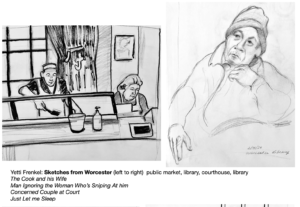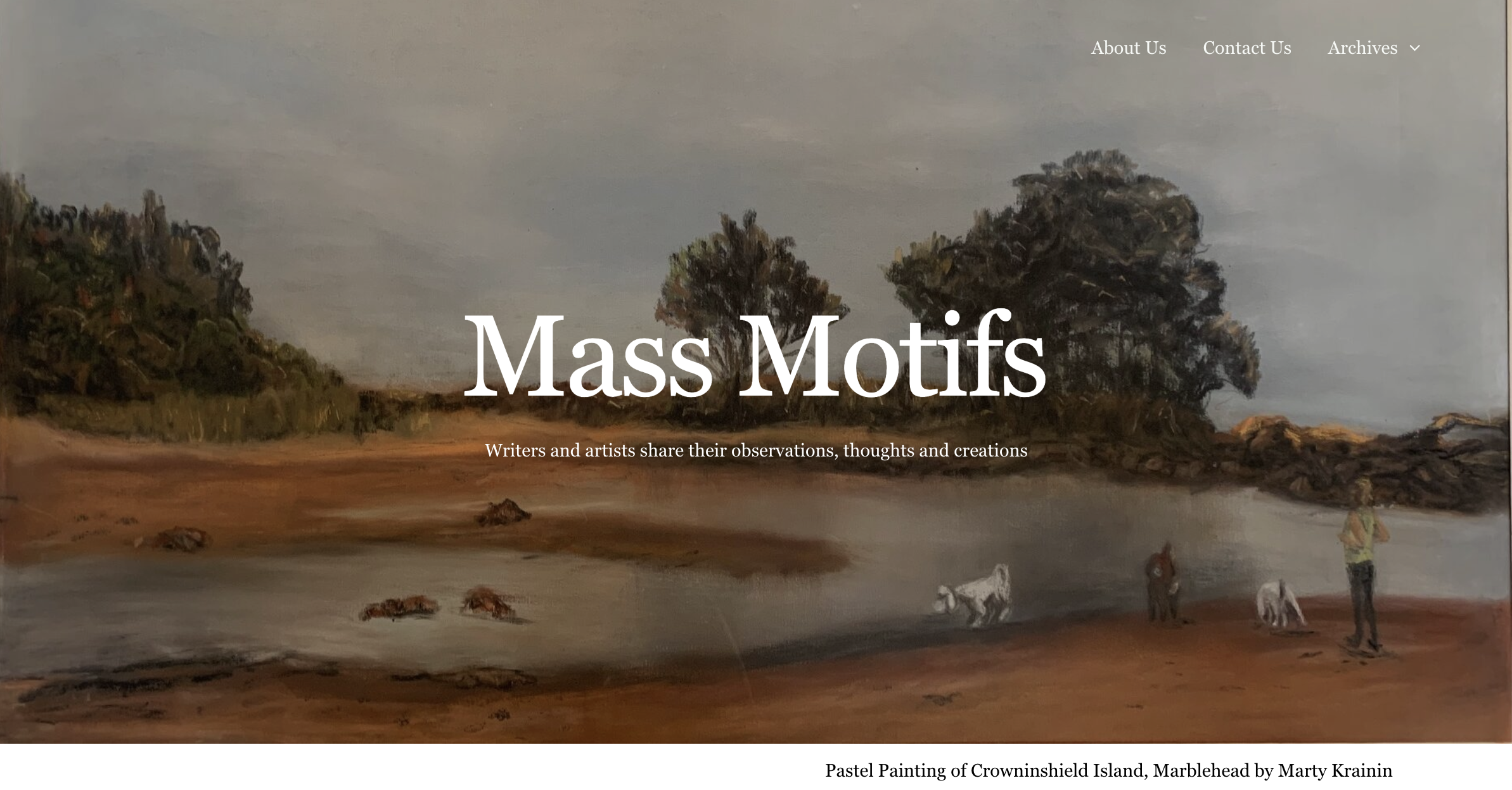
October 3, 2024
Power of Flowers —
New England Fall Flower Show
Story by Karen Brockelbank
Photos by Karen Brockelbank and Bette Keva
The New England Fall Flower Show was held at The Garden at Elm Bank, the home of the Massachusetts Horticultural Society, in Wellesley on September 21 and 22, 2024. I went there as a representative of the Garden Club Federation of Massachusetts, reporting for their quarterly newsletter, The Mayflower. New to the world of garden clubs, and a neophyte when it comes to the appreciation of flowers, I only had a vague idea of what to expect. Flowers in vases? Surely. Experts pointing out details I never would notice? Absolutely. What I encountered was beyond my imagination, and an experience that I will never forget.
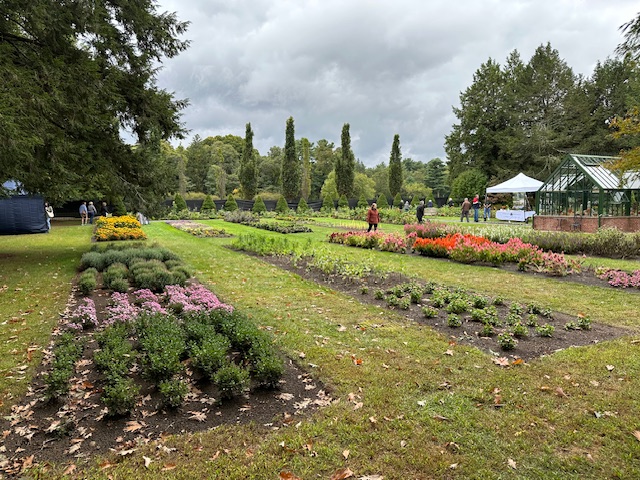 Upon entry to the main hall, I noticed the most exquisite miniature gardens. Tiny reproductions of outdoor landscapes had been recreated down to the most excruciating details, including a gazebo, a footbridge over a reflective pond, and a diminutive greenhouse. I paused for a moment to gawk before moving on.
Upon entry to the main hall, I noticed the most exquisite miniature gardens. Tiny reproductions of outdoor landscapes had been recreated down to the most excruciating details, including a gazebo, a footbridge over a reflective pond, and a diminutive greenhouse. I paused for a moment to gawk before moving on.

The “creative arrangement” categories were mounted on pedestals in the middle of the room. I was drawn to several large, unusual looking arrangements and noticed that the first prize winner had been awarded the prestigious Ruth A. Wallack Award, a prize I dimly remembered was highly coveted.
As I looked at the winning design by Meghan Harris, I read the judges’ comments, “The exciting combination of contrasting form, texture and color achieves a modern line mass design.” Indeed! Who would have thought to combine leaves of sansevieria with bamboo, and secure them to a scaffolding-like structure with a small bunch of pink and green flowers tied in the middle? I shook my head and marveled. It was stunning.
This was only the beginning. The “Harmonious and Haphazard” category was equally interesting, with arrangements that boasted a front and back design, like theatre masques (if you didn’t walk around the other side of them, you missed half the show.) The “Hale and Hartley” category were small arrangements mounted among dishware, glassware and other selected props like frames and linens. An interesting opportunity for creativity! Although all the entries were amazing, it was the third-place winner by Austin Seeley that caught my eye, with its bright yellow flowers. And even though the judges thought the placement of components on the left side “disturbed the balance”, to me the creativity was first-rate. Who would have known that flower shows could be this fun!
The “Hot and Humid” category showed off two different height arrangements of the same colors and flowers with an umbilical cord of sorts that connected them. This category was visually unusual (a woman next to me said of Rita Cutroni’s second place winning design, “It reminds me of Dr. Seuss!”) but the winning arrangement by Andrea Little was declared “a creative design of outstanding beauty” and “stands above the crowd with its artistic use of color harmonies, components and form” by the judges. I was beginning to understand that the wining artisans were creating sculpture (albeit temporary) using live plant material. What a specialized talent.
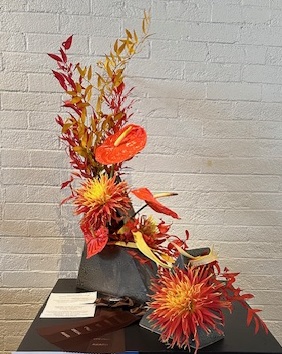
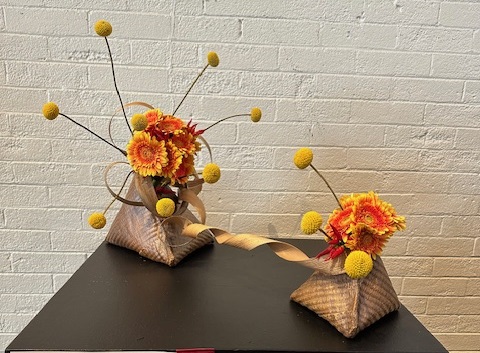
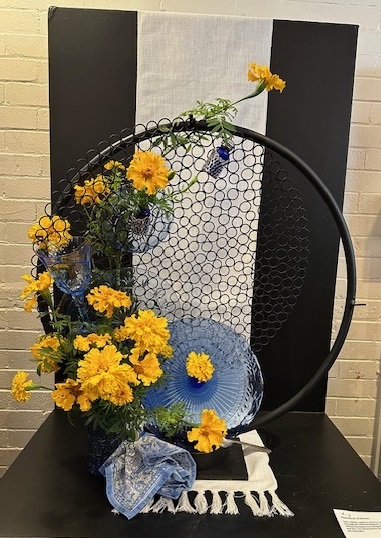
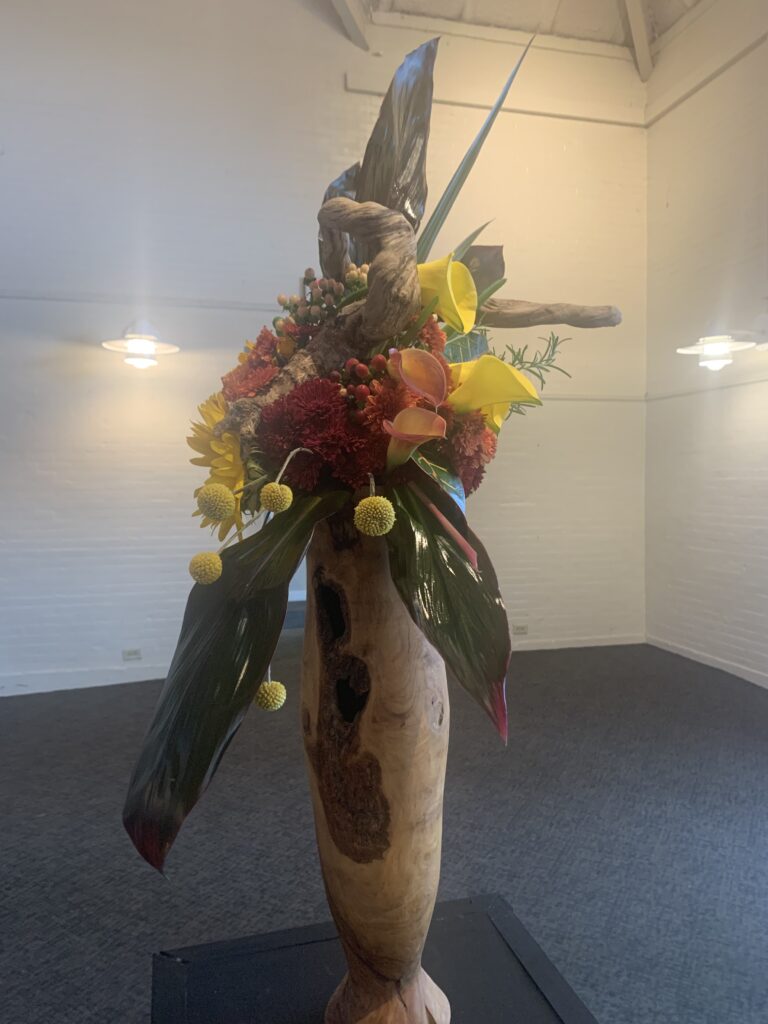
There were several different photography displays in the Educational category, and an entire tent for Amateur Horticulture where the age requirement was 18 or younger. As I departed to explore the gardens, I was impressed that there appeared to be something for everyone who wanted to enter the show, from expert arrangers to their children or grandchildren.
The Gardens at Elm Bank, a 36-acre estate in Wellesley, is the home of the Massachusetts Horticultural Society, which is the oldest formally organized horticultural institution in the United States. It has grown in size and been based in different locations since its beginning in 1829, but Elm Bank has been its home since 1996. Originally a private residence built in the 17th century, Elm Bank changed hands several times during the 20th century. It served as a seminary, a summer camp, and a technical school before being protected on the National Register of Historic Places in 1987, and finally becoming the home of the Massachusetts Horticultural Society who then pledged to bring Elm Bank back to life for generations to come.
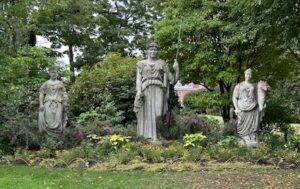
The main drag took me straight to three enormous Roman statues: Flora, Ceres and Pomona, whose gaze overlooks a beautiful green expanse surrounded by 100-year-old trees. Pathways wander diagonally over the grounds, crisscrossing the many gardens on the property. There is a formal Italian Garden, a Shade Garden, a Dahlia Garden, and a Labyrinth among other hideaways.
Naturally concerned with ecology, Elm Bank boasts a Teaching Herb Garden, a Seed to Table Vegetable Garden and a Pollinator Meadow. There was so much to see, it was like a small city filled with different gardens connected together. The staff were helpful and kind and spent time answering all my questions. At the end of the day, instead of feeling intimidated by my lack of knowledge, I only thirsted for more.
The Gardens at Elm Bank hosts the Fall Flower Festival next year and I intend to visit again, hopefully with a better understanding of all the Seussian award categories so that I may fully understand them. And a picnic on the grounds? Definitely. Pomona awaits.

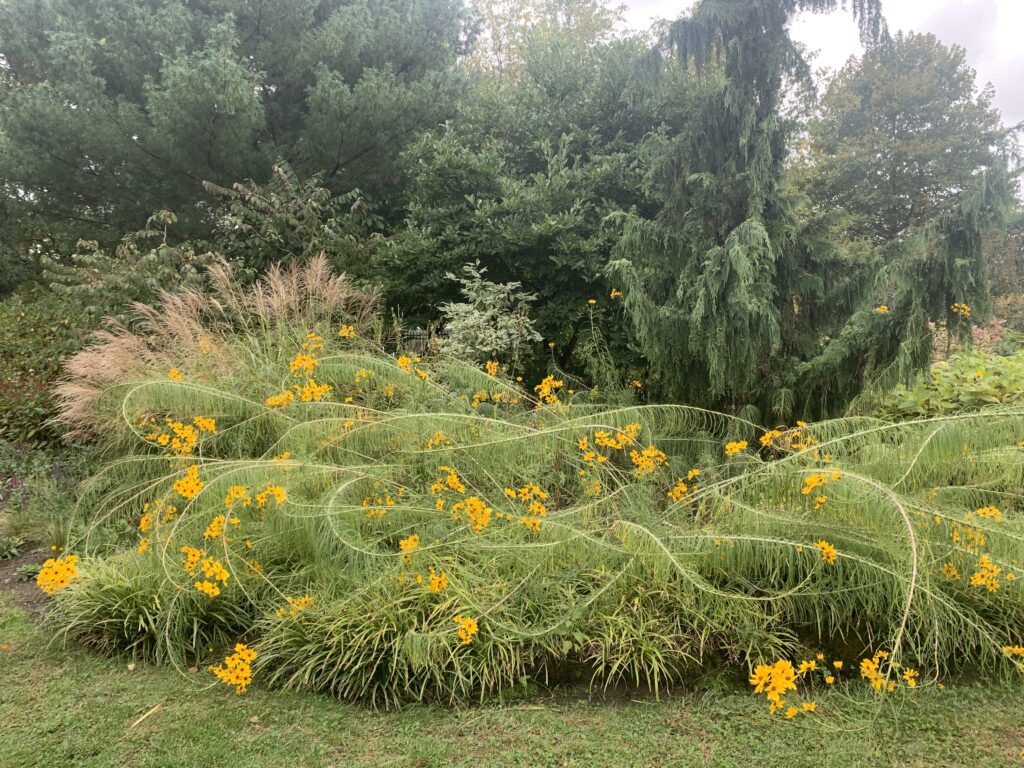
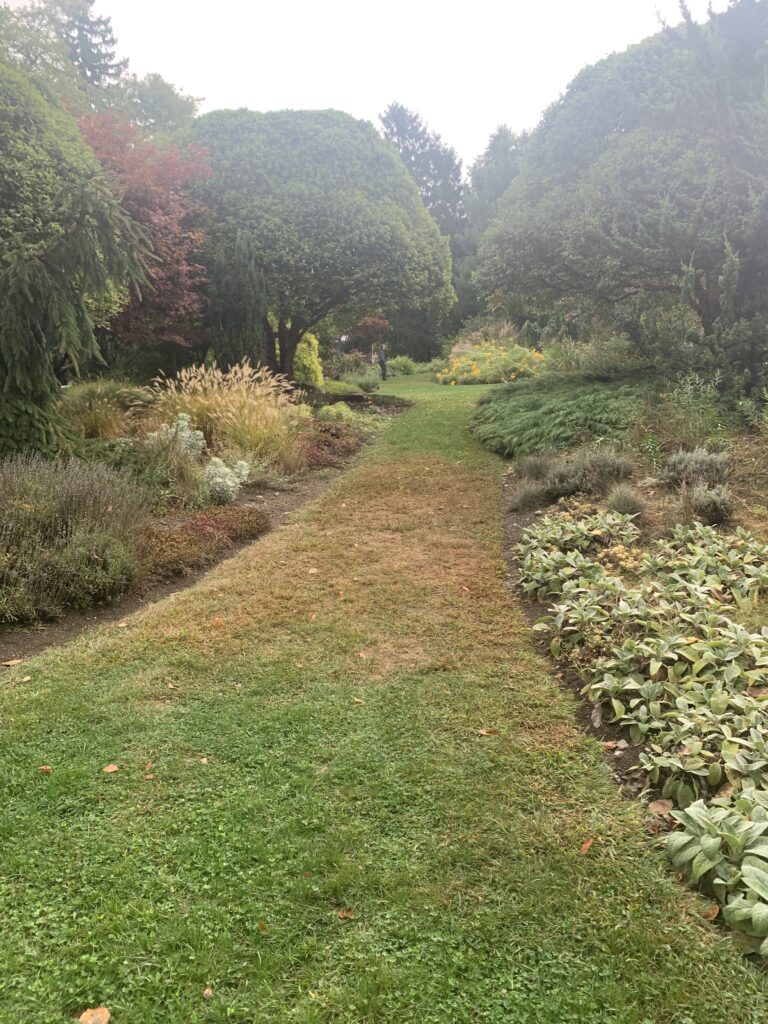
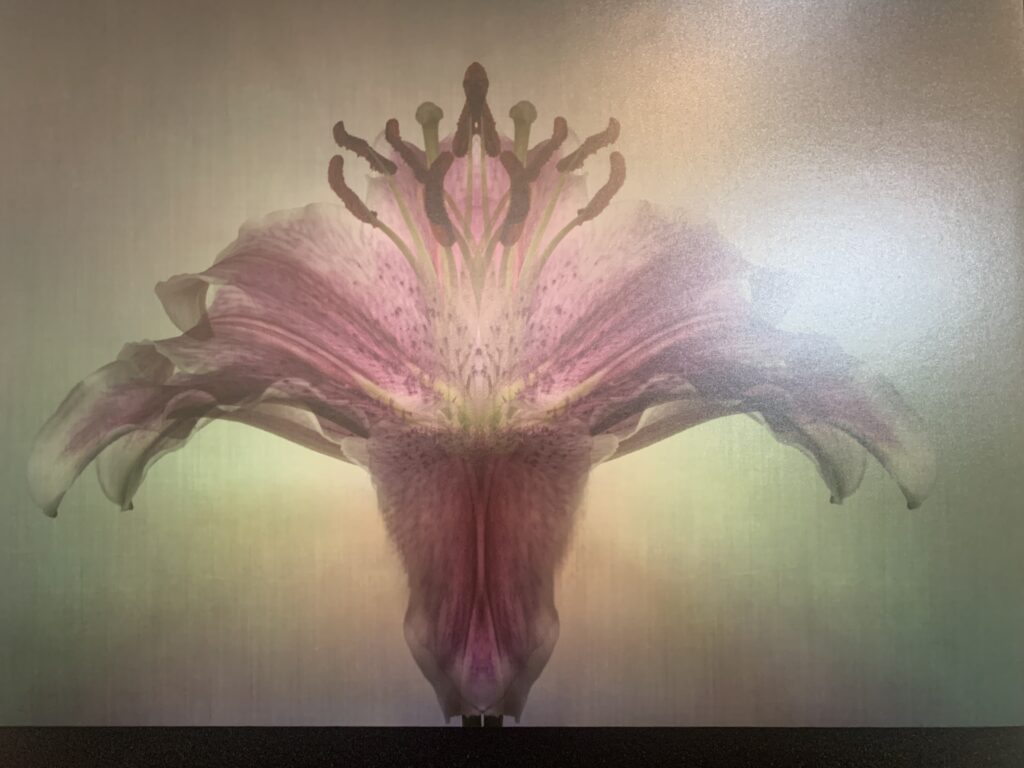
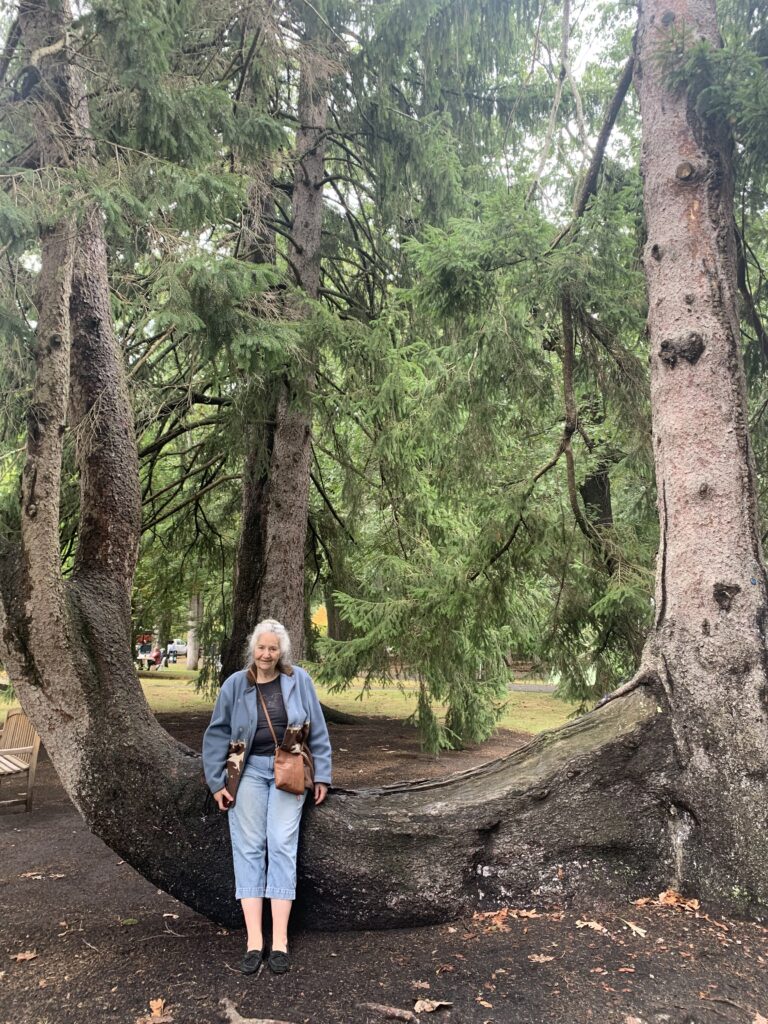
September 25, 2024
Lynn Ferry to the Greenway and Chinatown in the Waning Days of Summer
Story and Photos by Bette Keva

Lest anyone accuse the Ginger Ramblers, my hiking group, of inactivity, on one fine September Sunday the group yanked themselves off their sofas, bid farewell to the little lady, gentleman, dog or cat, dusted off the mites from our sailor outfits and headed out to spend an adventurous day on land and sea.
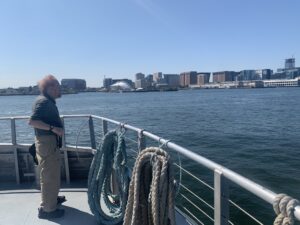
The Ginger Ramblers connoitered at Lynn’s Blossom Street pier, then strode aboard the venerable Lynn Ferry where we held onto our hats as we traversed the mighty Atlantic. Forty-five minutes later more or less, with wind-swept toupees and wigs askew we landed, no, we glided, into Long Wharf at the base of State Street, once a hub of maritime trade. Unlike the famed Massachusetts sailors of old, we Ginger Ramblers staggered off the boat as we got our sea legs re-accustomed to land. Aye, Mateys, a perilous journey it was.
Mindlessly following our intrepid captain, Richard, we headed for the Rose Fitzgerald Kennedy Greenway where we were instantly pitched into the urban hullabaloo of tourists as well as real people vying to purchase sustenance from scores of street vendors.
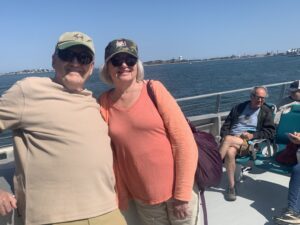
The Greenway is a swath of landscaped greenery that gently weaves across neighborhoods from the North End, the Wharf District, the Financial District and ending at Chinatown. It’s a breath of fresh air in a sea of concrete where office buildings get more plentiful and taller every year despite the fact that everyone is working from home. We Ginger Ramblers apparently don’t ramble too far outside of the woods because many of us were surprised that Boston is looking more like Manhattan than Newburyport.
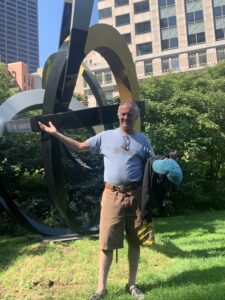
Tall ornamental grasses in sustainable gardens bulging with seasonal flowers and bamboo stalks are lined beside 900 trees (yes, I counted them). They are birch, eastern prickly pear cactus, magnolias, ’okame’ a flowering cherry tree, gingkoes, elms, and a golden raintree. Grape tomatoes hanging tantalizingly on vines brushed against our clothing as we strode the mile and a half along the city’s innovative answer to burying the expressway and making Boston beautiful and breathable. It opened 16 years ago in October.
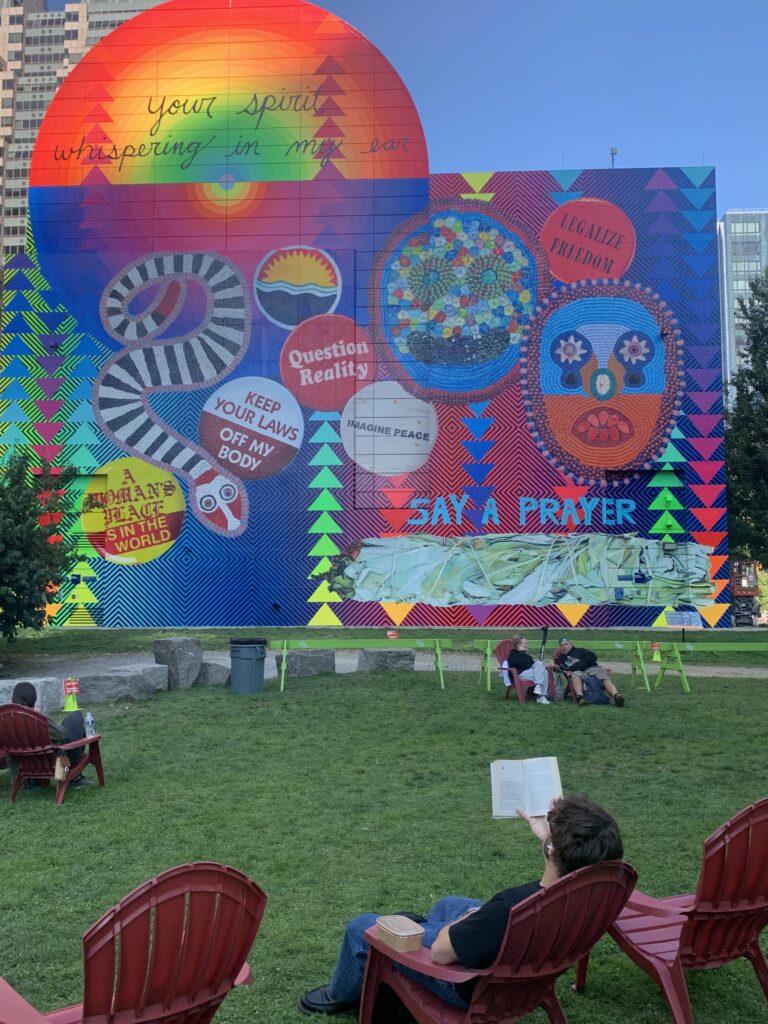
We passed a carousel with painted creatures — not horses —but uniquely Boston inhabitants: whales, lobsters, grasshoppers, birds and squirrels. The Greenway sports several fountains and huge art installations.
What luck! We entered Dewey Square and happened upon the finishing touches of the newest Greenway installation by Choctaw and Cherokee Native American artist Jeffery Gibson who calls it, ‘Your Spirit Whispering in my Ear.’ Sprinkled throughout with sayings, my favorite is, ‘Question Reality.’
Finally, we emerged from this fantasyland of art and gardens and, opps, we’re not in Kansas anymore, Dorothy. We were facing South Station which is dwarfed by a brand new and more than likely useless shining new building of indeterminant stories and a knot of criss-crossing intersections where people dash across hoping to land on the other side before the pedestrian countdown gets to zero.
In a moment, we entered the familiar gates leading into Chinatown. It was a short walk to Wakuwaku, a favorite of some of the Ginger Ramblers, which is code for Richard likes it. Wait personnel moved several tables together to accommodate the ten of us. Everyone else ordered a ramen bowl of one type or another, but I naively ordered the Okonomiyaki — Japanese fried vegetables, carrot, cabbage, onion pancake, topped with bonita flakes with tonkatsu sauce and kewpie mayo. What could go wrong?
It was a moving experience. Very moving. The order was set before me and as I began to eat, I did a double take when the shaved bonita flakes on top of the vegetarian dish started, ahem, MOVING! After summoning the waitress, she smiled and explained that bonita flakes are made from dried, smoked, and shaved fish. So light, they sway and move when placed atop a hot pancake.
Finishing our meals, we meandered through the neighborhoods back toward Long Wharf. While waiting at the Aquarium for our 4 p.m. return ferry to Lynn, we were treated by a mesmerizing show of Harbor Seals swimming in tanks. Although we didn’t have to enter the Aquarium, or pay the fee, we got to hear an employee relate the story of the seals, how they came to be here and what happy, fulfilled lives they lead in captivity. It was a fairytale ending to a most enjoyable Ramble with my North Shore and Boston friends on a perfect late summer day.
If you want to catch that ferry into Boston, do it before October 31 when it stops for the cold seasons.
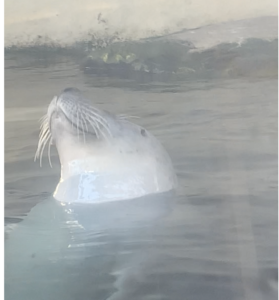

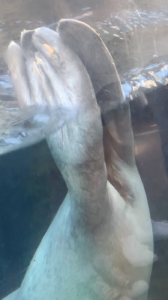

August 31, 2024
Grassy Dunes, Turquoise Sea, Crane Beach Beckons
Story and Photos by Caryn Coyle
Last night’s downpours have formed puddles on the sand parking lot of Crane Beach. I step carefully around them to the boardwalk stairs that lead over the dunes to the beach. On a perfect beach day, the lot is filled to capacity, and it is estimated that 350,000 people enjoy Crane each summer.
Purchased in 1910 by Chicago industrialist Richard Teller Crane Jr., the beachfront property at the end of Argilla Road was his summer estate. His widow, Florence Higinbotham Crane, donated the more than 1,000 acres to the Massachusetts Trustees of Reservations in 1945. The Trustees call the pristine white-sand beach, Crane Beach, though many of us who are of a certain age, still call it Crane’s.
As a child, a trip to Crane Beach was a special occasion. Along with the scratchy, plaid wool blanket, I remember a thermos of lemonade with a stack of waxed Dixie cups, deviled ham and pickle sandwiches and a tin of toll house cookies. All were packed in a large cooler that two of us would have to haul after a drive that seemed endless to Crane. My mother, who would rub Sea and Skin suntan lotion on us, never failed to tell us that Crane was the most beautiful beach in all of New England.
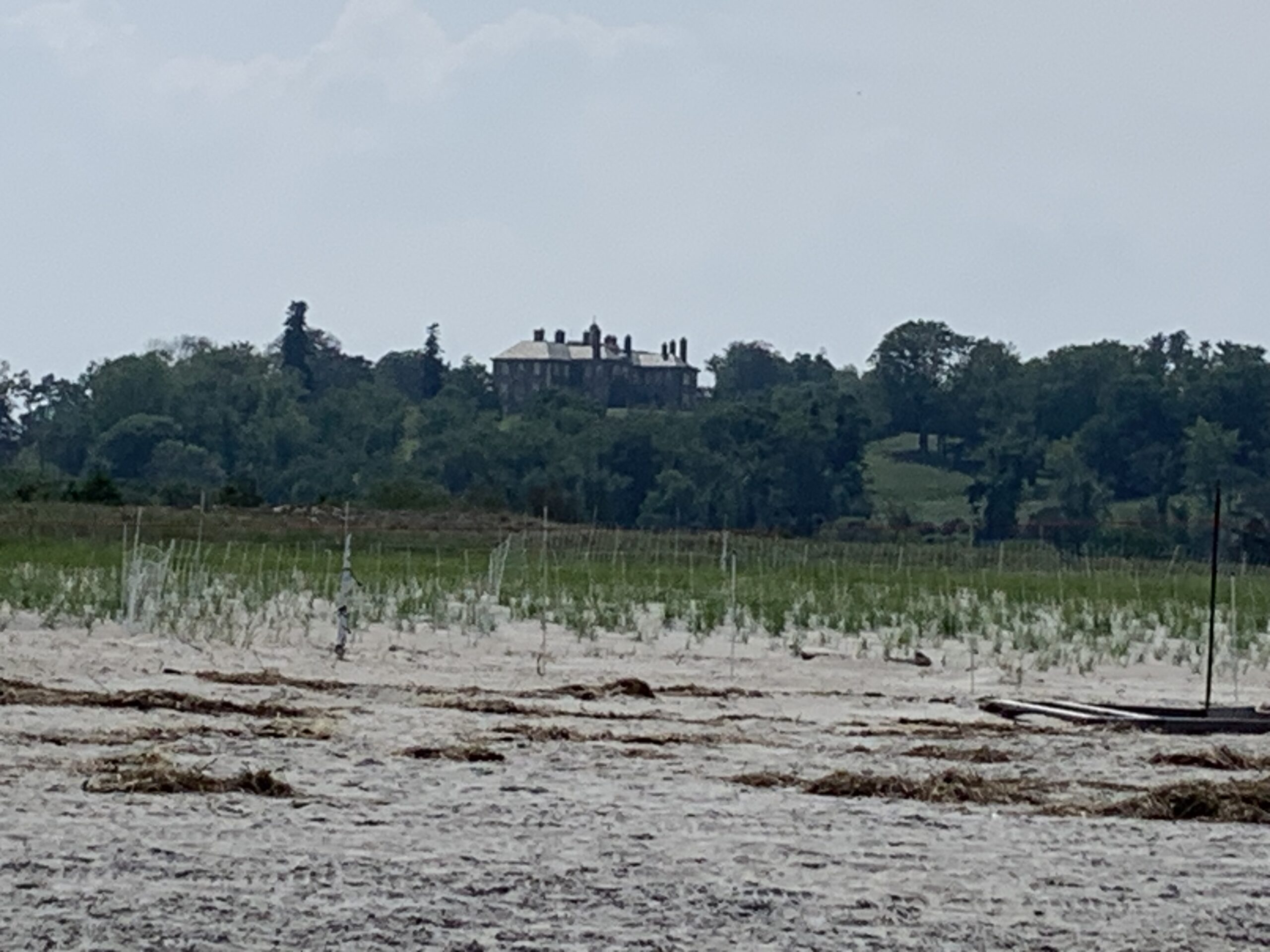
The Pawtucket Indians, who once inhabited the beach and its surrounding land, referred to it as Agawam Place, which meant “the other side of the marsh.” Massachusetts purchased the land from the tribe in 1637. After the Revolutionary War, the town of Ipswich, where Crane Beach is located, sold part of the property to help pay the town’s assessment for the costs of the war. The beach, however, was saved for the town. There is a section of Crane Beach that is accessed by the town’s residents and their parking lot is separated from the lot maintained by the Massachusetts Trustees of Reservations. In 1968, John Updike’s novel, Couples, described the resident’s beach and the town. Though Updike lived in Ipswich, he fictitiously placed the location of Couples south of Boston in a town he called Tarbox.
The sand of Crane Beach is light, inviting and it appears on the horizon as you move over the grass topped dunes on the boardwalk from the parking lot. The sand can scorch if the weather is hot. It is best to wear water shoes, or hiking sandals that do not slip off in the hot sand.
The water gleams; green/blue/turquoise and you can see Plum Island, a mound of green on the horizon. A boat might speed along the water, far from the beach and beyond the buoys that separate the boat from the swimming area. In June, the water will be cold. It may still seem chilly even a month later.
On my first visit of the summer, there is no one in the water. The wind is brisk and the sea air is inviting but not hot, steamy.
From my folding beach chair, I can see three fishermen seated, with poles, at the water’s edge. They are laughing and talking. But they are just far enough away from me that I cannot make out what they are saying.
The light blue sky is dotted with fluffy clouds and I rise to walk along the water. The fishermen wave to me. To my left, above the trees, the central copula and chimneys of Crane Castle are visible. If I stroll in that direction, I will eventually find Steep Hill Beach, which has a path up to the castle’s grand allée. To my right, Gloucester and Rockport are a hazy blue gray on the horizon.
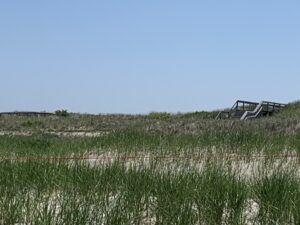
Walkway through the dunes
I walk east toward the Gloucester shoreline and step into the water. Thrilled at its coldness, I continue to wet my feet as I stroll on the damp sand. The grass topped dunes lie beyond the few people I notice who are dotting the beach. There are not many. The season hasn’t really begun yet, even though Memorial Day is past.
When I turn to head back to my spot, a lone seagull, white wings spread out, soars above me. I don’t see another anywhere and he lands near me. Folding his wings onto his back, he has ribbons of gray feathers down each of his sides. The seagull cocks his head and takes a few web footed steps toward me before he spreads his wings out again and flies off.
By the end of the summer, now approaching Labor Day, I will be diving into the ocean at Crane, with a t-shirt to protect my skin from the sun. Wet from my dip in the Atlantic, I will welcome the t-shirt’s coolness when I resume my seat on the beach. Another summer will have flown past.
*******************
August 12, 2024
The Zen of Sketching
Go Out Into the World and Draw
By Yetti Frenkel
When I was 18 and had spent one year in art school, the summer stretched before me like a blank canvas and I felt the need for adventure. I packed my little Renault LeCar with some clothes and my dog and headed for Bar Harbor, where I got a job working as a maid in a motel. I made beds and cleaned bathrooms until noon, then spent the afternoon walking in Acadia National Park and reading classic literature which I borrowed from the local library. It was a time of introspection and few responsibilities, and I remember being absorbed by the books in a way I have never been able to achieve since. I especially loved Flaubert’s Madame Bovary and Voltaire’s Candide. Flaubert astonished me with his empathy for the female mind (when asked how he could write so believably about a woman’s frustrations he replied “Madame Bovary, c’est moi”), and Voltaire’s sharp mockery of the theory that “this is the best of all possible worlds”, taught me the value of writers who observe and express the human condition.
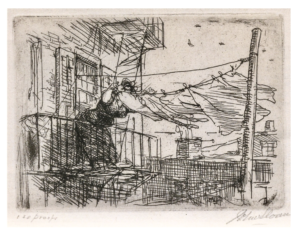
They were the literary equivalent of the artists I admired, whose work communicated with force and sincerity about the pain of being human. They included Käthe Kollwitz, who lost a son in World War I and a grandson in the second, and whose drawings were powerful black and white statements about the innocent casualties of war and poverty, the satirical drawings of Hogarth and Daumier, and Goya’s terrifying etchings. I also loved the artists of the Ashcan School, who painted and drew scenes of everyday life in New York in the late 1800s and early 1900s and whose work was full of life and, at times, humor. besides their social conscience, one thing all of these artists had in common was the ability to draw. I desperately wanted to be able to draw well; there were so many things that I wanted to express and I lacked the skill to depict them.
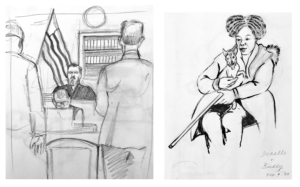
I had many good teachers, and some great ones. George Gabin was my drawing instructor at Montserrat School (now college) of Art, and he gave his students many valuable tools to help us draw accurately. I also studied portraiture with Louis Gippetti at the School of the Museum of Fine Arts, and sketching with Bill Oakes at the New England School of Art and Design . Bill was a documentary artist; he covered the Watergate Trials, sketching in the courtroom at a time when cameras were not allowed. He had developed exercises to help students learn to observe and draw quickly, and I felt terribly competitive with him. This was a good motivator, and I began to draw every day in my sketchbook. I went to Central Square in Lynn and sat in my car, drawing the commuters waiting for the buses, or people waiting for a meal outside My Brother’s Table. I took my sketchbook on the road to San Diego where I drew vagrants and vendors and strippers in the seedy part of town. Bill Oakes inspired me to begin to work in series, documenting the things I found fascinating with both a pencil and a camera, and later working the sketches up into finished paintings. I’ve documented farm auctions in Iowa, gamblers and grooms at the Suffolk Downs Racetrack, the Big Apple Circus where I worked as a groom for a summer, and commuters in Boston.
Now I teach my own students at the Worcester Art Museum, and try to inspire them to do the same. On Wednesday afternoons I take a group of students out to sketch in Worcester, which has a wealth of characters to choose from. We draw at the courthouse, the bus depot, the Public Market, and Institute Park, but our favorite place to sketch is Worcester Public Library.

Libraries are the ultimate symbols of democracy; they are open to all and are filled with information that you can find without sacrificing your privacy. Even the availability of the internet has not made the library obsolete, it has just broadened the services that the library provides.
One of these services is shelter. There are a lot of homeless people in Worcester, and many of them spend a portion of their day at the library. They are wonderful models for art students because they tend to stay in one place for a while, and in general, they are friendly and curious and don’t mind being drawn. There is also a chess table, and a tabletop puzzle. People of all ages and ethnicities come to read, to study, for language tutoring, or to meet with their social worker. Sometimes I write down snippets of conversations that I overhear, or the names of people who talk to me. It’s a rich tapestry for the artist to choose from.
There is nothing like being in the world with a group of colleagues, listening to the same stories and sharing the same experiences while you draw. Artificial Intelligence will never rob us of our ability to experience and interpret the world, at least not until robots take over entirely. Until then, I encourage everyone to take a sketchpad. a pencil, and a couple of friends and go out into the world to draw.
